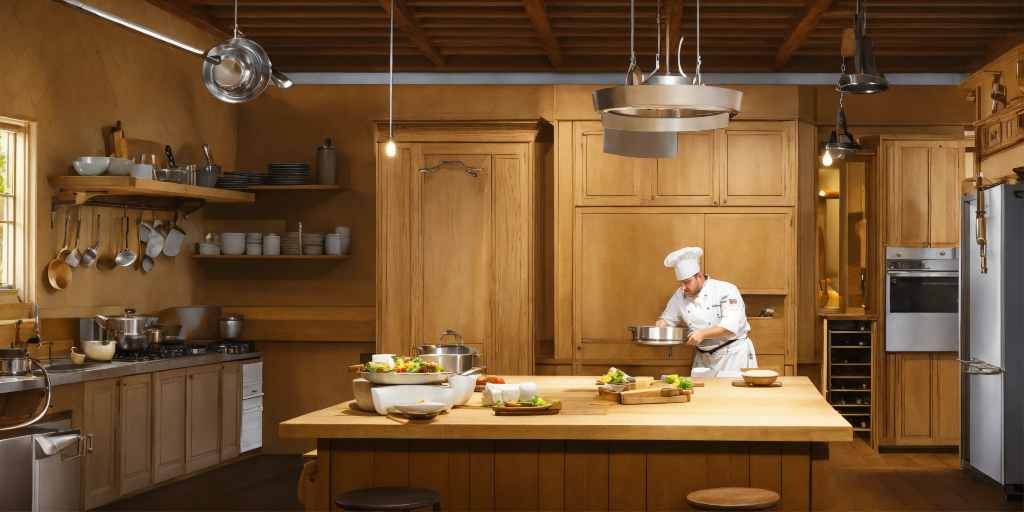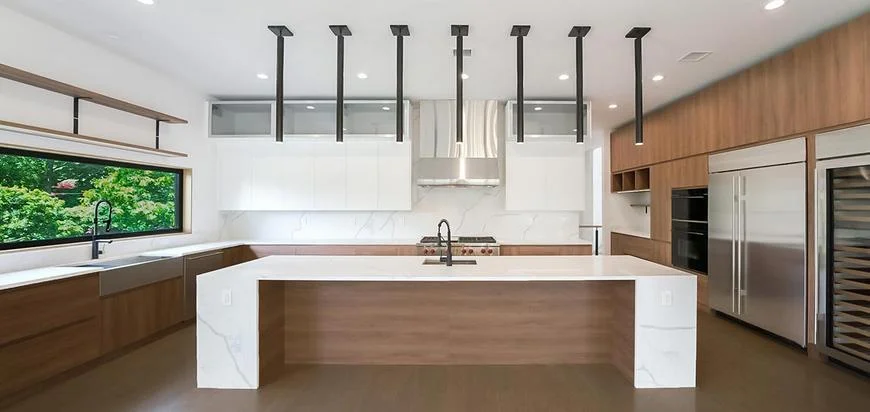The traditional Italian kitchen design seamlessly combines the cooking and dining areas, providing a space for family and friends to cook, converse, and dine together. The kitchen’s aesthetic blends opulence with rustic charm, featuring intricate copper accessories paired with wooden units, and accentuated by exposed brickwork and stonework framing the room. Let’s explore the methods to incorporate an Italian-style kitchen design into your home, crafting a warm and sophisticated space for cooking and dining.
The primary purpose of this article is to provide guidance and inspiration for creating an Italian-inspired kitchen design. It aims to help readers understand the key elements and principles that define the traditional Italian kitchen aesthetic, enabling them to incorporate this warm and sophisticated style into their homes.
People should read this article if they:
- They plan to renovate or redesign their kitchen and are interested in the Italian style.
- Want to learn about the essential components of an Italian-inspired kitchen, such as color palettes, cabinetry, countertops, accents, and appliances?
- Seek practical tips and suggestions on adapting and personalizing the Italian kitchen design to suit their specific kitchen size and layout.
- Desire to create a kitchen space that combines functionality with a warm, rustic, inviting atmosphere, perfect for cooking, dining, and socializing.
- They appreciate the rich cultural heritage and design principles behind the traditional Italian kitchen and wish to incorporate these elements into their homes.
Selecting a color palette

The classic Italian kitchen earthy tones such as cream, brown, and green. These hues are often reflected in the stone and brickwork of the walls and floors, as well as in the exposed ceiling beams. Adapting this look doesn’t necessarily require a complete renovation; the choice of color scheme will depend on the size of your kitchen space and the amount of natural light it receives. In larger, well-lit kitchens, darker shades like roman leaf, oatmeal, and moss stone can be used to create a rich and warm atmosphere. For smaller kitchens, lighter colors such as mink, Gatsby green, and pebble can be employed to open up the space and emulate the Italian style.
Cabinetry and countertops
Wood and stone are central to Italian-style kitchens, with traditional wooden units often crowned with granite countertops. Wooden ceiling beams are complemented by stone-tiled floors, which are ideal for maintaining a cool environment in warmer climates. Regardless of the kitchen’s size, wooden units are essential for achieving an Italian design, particularly those featuring shaker or inset door styles with knob or bar handles. Granite or wood countertops, such as Venetian Gold or dark walnut, provide a luxurious finish that complements the rustic feel of the room. Cabinets can incorporate glass-paned doors to showcase cooking equipment, ingredients, and crockery. A kitchen island is a valuable addition to larger kitchens, providing space for both cooking and dining.
Accents and appliances
Italian-style kitchens focus on showcasing cooking equipment, ingredients, and appliances rather than concealing them. A range cooker serves as a focal point, highlighting a passion for cooking for large groups. Copper accessories, including light fixtures and displayed pans, add a touch of Italian elegance. When it comes to sinks, both ceramic and stainless steel options are suitable, with the primary consideration being ample space for washing and food preparation. Displaying Mediterranean ingredients like lemons, pasta, and wine adds a practical and trendy finishing touch to the kitchen.
Italian kitchen design seamlessly combines practicality with beauty, offering a space for socializing and food preparation, making it an excellent choice for those who want to make the kitchen the heart of their home.
Real Case Study Examples

- The Johnsons, a family of four, wanted to transform their outdated kitchen into a warm, inviting space reflecting their love for Italian cuisine and entertainment. Following the guidance from the article, they opted for a color palette of mink and Gatsby green, complemented by dark walnut wood cabinets and a granite Venetian Gold countertop. A copper range cooker became the focal point, and they incorporated exposed beams and brickwork to add rustic charm. The result was a stunning Italian-inspired kitchen that seamlessly blended functionality and style.
- Sarah, a young professional living in a small apartment, was captivated by the idea of creating an Italian-inspired kitchen within her limited space. Taking cues from the article, she chose lighter colors like cream and pebble to open up the room. She installed shaker-style wooden cabinets with glass inserts to display her collection of Italian ceramics and ingredients. A copper pendant light and a ceramic farmhouse sink added the perfect finishing touches, transforming her compact kitchen into a charming Italian-inspired oasis.
- The Smiths, a couple passionate about cooking and entertaining, embarked on a complete kitchen renovation to create an authentic Italian kitchen experience. Inspired by the article’s recommendations, they opted for a roman leaf and moss stone color scheme, complemented by exposed ceiling beams and stone-tiled floors. A large kitchen island with a granite countertop became the centerpiece, providing ample space for cooking and gathering with friends and family. Copper pots, pans, and light fixtures added warmth and elegance to the space, creating a genuinely Italian-inspired culinary haven.
By providing real-life examples, readers can better visualize and appreciate how the principles outlined in the article can be applied to transform their kitchens into Italian-inspired spaces that effortlessly blend style, functionality, and cultural heritage.
Conclusion
The Italian kitchen design brings together form and function to create a warm, convivial space for cooking, dining, and socializing. Key elements like exposed beams, stonework, wood cabinetry, and copper accents marry sophistication with rustic charm. Adaptations like color selection, island additions, and displayed cookware allow the style’s essence to suit any kitchen size. This versatile and beautiful design makes the kitchen the home’s natural gathering place.
FAQs
What are some classic color choices for an Italian kitchen?
- Earth tones like cream, brown, green, Roman leaf, oatmeal, and moss stone capture the style’s warmth. Lighter hues can brighten smaller spaces.
What type of cabinetry works best?
- Wood cabinets with shaker or inset doors and knob or bar handles fit the aesthetic. Glass-front uppers showcase contents.
What countertop materials pair well?
- Granite, wood, or ceramic countertops complement the look. Venetian Gold granite or dark walnut wood offers high-end finishes.
What metals suit an Italian kitchen?
- Copper pots, pans, and light fixtures infuse rooms with elegance. Other metals take a backseat to highlight copper’s richness.
How can I adapt elements to my kitchen’s size?
- Islands with storage and seating optimize larger kitchens’ flow and function. Displaying ingredients/cookware personalizes any size, accentuating style priorities.
